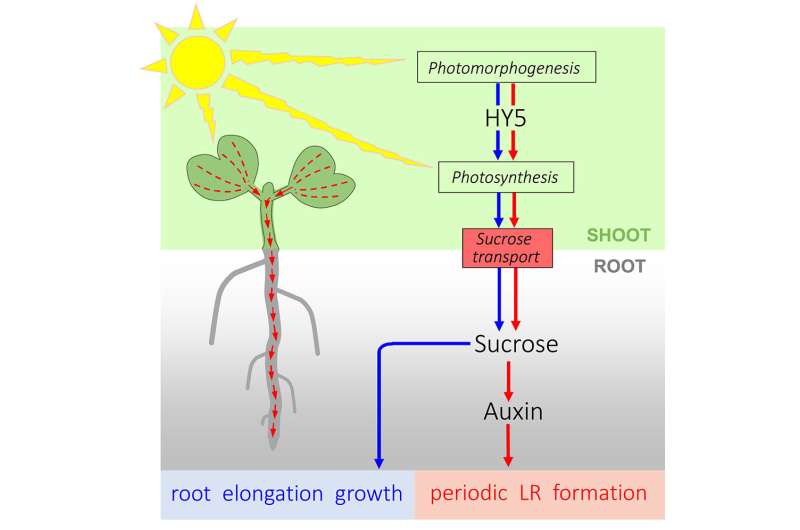This article has been reviewed according to Science X's editorial process and policies. Editors have highlighted the following attributes while ensuring the content's credibility:
fact-checked
peer-reviewed publication
trusted source
proofread
Study shows light conveyed by signal-transmitting sucrose controls growth of plant roots

Plant growth is driven by light and supplied with energy through photosynthesis by green leaves. It is the same for roots that grow in the dark—they receive the products of photosynthesis, in particular sucrose (sugar), via the central transportation pathways of phloem.
In their study published in Current Biology, Dr. Stefan Kircher and Prof. Dr. Peter Schopfer from the University of Freiburg's Faculty of Biology have now shown in experiments using the model plant Arabidopsis thaliana (thale cress) that the sucrose not only guarantees the supply of carbohydrates to the roots, it also acts as a signal transmitter for the formation of light-dependent root architecture.
It does this in two ways: firstly, sucrose directly guides elongation of the primary root. Secondly, the sucrose that is transported to the tip of the root then regulates the production of the plant hormone auxin. This hormone drives the rate of formation of new lateral roots, which—along with elongation of the primary root—is synchronized by the joint signal transmitter.
"This enables the root growth to adapt to the current photosynthesis performance of the leaves as light and other environmental conditions change, for example, on the change from day to night," says Kircher.
Experimental evidence
To demonstrate that the sucrose produced through photosynthesis is the decisive signal transmitter, Kircher and Schopfer placed the plants in a room with light but with no carbon dioxide (CO2) in the air, thus making photosynthesis impossible.
The outcome was that no more lateral roots were formed. This result was confirmed by another experiment in which the two biologists treated either the leaves or the roots in the dark with a solution of sucrose. In both approaches, lateral roots developed the same as in control plants that were exposed to light.
"These results show that the production of sucrose in leaves is necessary for the formation of lateral roots. And it confirms the hypothesis that sucrose acts as a signal transmitter for light stimuli," says Kircher.
Activation of auxin biosynthesis by sucrose signal
In earlier studies, researchers had already shown that the auxin produced in the roots from the amino acid tryptophan drives the rate of development of new lateral roots. Kircher and Schopfer have now shown how sucrose triggers this process.
To do this, they placed the plants in a dark room for two days and carried out various experiments to discover their influence on the formation of lateral roots. Administering tryptophan to the roots at the same time as treating the leaves with sucrose had the greatest effect. By contrast, tryptophan had little effect if it was applied to the leaves or without sucrose at the roots.
"These observations confirm that the sucrose produced through photosynthesis serves as a trigger for the synthesis of auxin," says Kircher.
More information: Stefan Kircher et al, Photosynthetic sucrose drives the lateral root clock in Arabidopsis seedlings, Current Biology (2023). DOI: 10.1016/j.cub.2023.04.061
Journal information: Current Biology
Provided by University of Freiburg
















